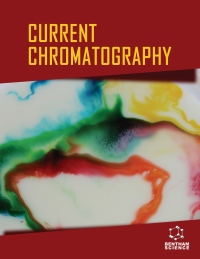- Home
- A-Z Publications
- Current Chromatography
- Previous Issues
- Volume 1, Issue 2, 2014
Current Chromatography - Volume 1, Issue 2, 2014
Volume 1, Issue 2, 2014
-
-
Recent Trends in Chiral Separations by Nano Liquid Chromatography and Nano Capillary Electrophoresis
More LessAuthors: Imran Ali, Zeid A. Al-Othman, Abdulrahman Al-Warthan and Hassan Y. Aboul-EneinChiral separation at nano scale is gaining importance in drugs development, proteomic, genomic and environmental sciences. Generally, traces of drugs are found in our body for several weeks. These cannot be detected by conventional analytical techniques. The present article discusses the advances in chiral resolution at nano scale using nano liquid chromatography (NLC) and nano capillary electrophoresis (NCE). The instru Read More
-
-
-
Recent Development and Applications of Ion Chromatography
More LessIon chromatography was first introduced in 1975. Since then, it has been applied in most areas of the analytical chemistry. It is an effective technique used to analyze various inorganic and organic ions present in samples with different matrices. Importantly, ion chromatography has almost completely replaced the classical methods of ion determination. Its main advantages include: short analysis time; analysis of sm Read More
-
-
-
Headspace Gas Chromatography Methods and their Potential Industrial Applications
More LessAuthors: Itxaso San Roman, Maria Luz Alonso, Luis Bartolome and Rosa M. AlonsoThis article reviews the most recent and significant advances in headspace gas chromatography (HS-GC). The evolution and potential industrial applications in the last five years (2008 to present) are reviewed and discussed. The topics include a brief overview of the recent advances in HS-GC techniques and theory, followed by examples of new applications and instrumentation for the different headspace analysis technique Read More
-
-
-
Extraction and Detection Techniques for PAHs Determination in Beverages: A Review
More LessPolycyclic aromatic hydrocarbons (PAHs) are ubiquitary contaminants, which constitute a wide range of organic compounds. Many of them proved to be carcinogenic and mutagenic, produced mainly by industrial and non-industrial combustion processes, but also are present in water, air, soil, and as contaminants in foods, and beverages. Several industrial processes and artificial human activities can increase naturally environ Read More
-
-
-
Enantioresolution of Chiral Derivatives of Xanthones on Different Types of Liquid Chromatography Stationary Phases: A Comparative Study
More LessAuthors: Carla Fernandes, Madalena Pinto and Maria Elizabeth TiritanSince the development of chiral stationary phases (CSPs), liquid chromatography has emerged as one of the most useful methods for analyses and preparation of enantiomerically pure bioactive compounds. However, the key for success of enantioseparation lies in the first place in the choice of a suitable CSP having enantioselectivity for the target enantiomers. Thus, this work describes a comparative study of resolution of seven Read More
-
-
-
Stability Indicating Rapid Resolution LC Method for Determination of Valaciclovir Hydrochloride and its Application on Determination of its Active Metabolite Aciclovir in Human Plasma
More LessAuthors: Lobna A. El-aziz Hussein, Maha Farouk A. El-ghany and Marwa SolimanA sensitive, precise and environmentally friendly stability indicating Rapid Resolution Liquid Chromatographic (RRLC) method for the determination of valaciclovir HCl in presence of its degradation products was developed and validated. An isocratic separation was achieved using Zorbax SB phenyl column with flow rate of 0.3 mL min-1 and UV detection at 254 nm. The mobile phase was a mixture of 0.01M n-tetrabutyl amm Read More
-
Most Read This Month
Article
content/journals/cchg
Journal
10
5
false
en


